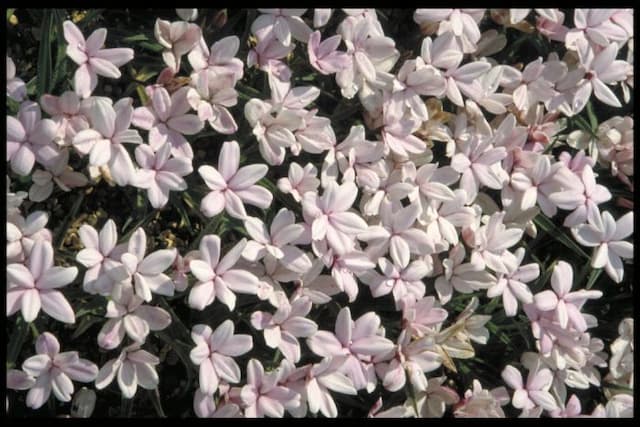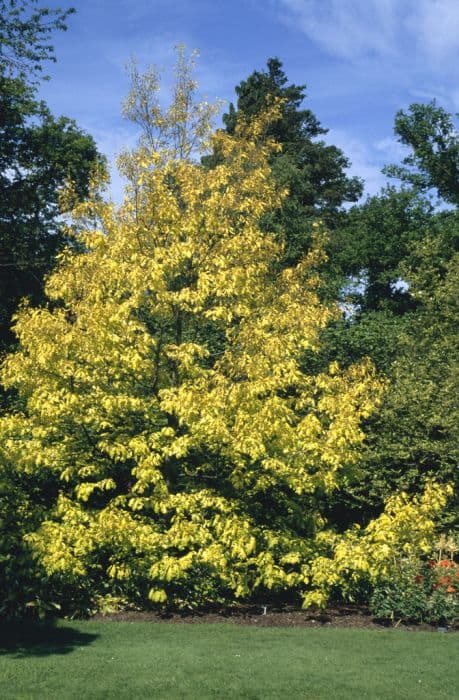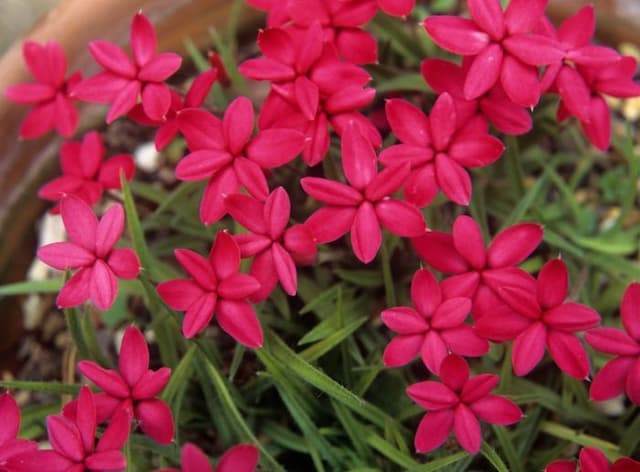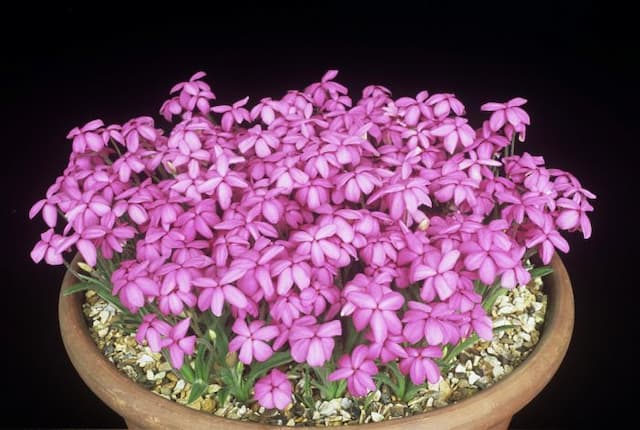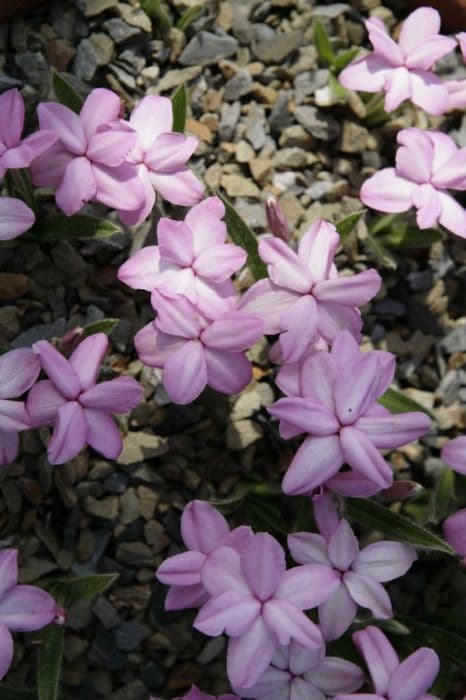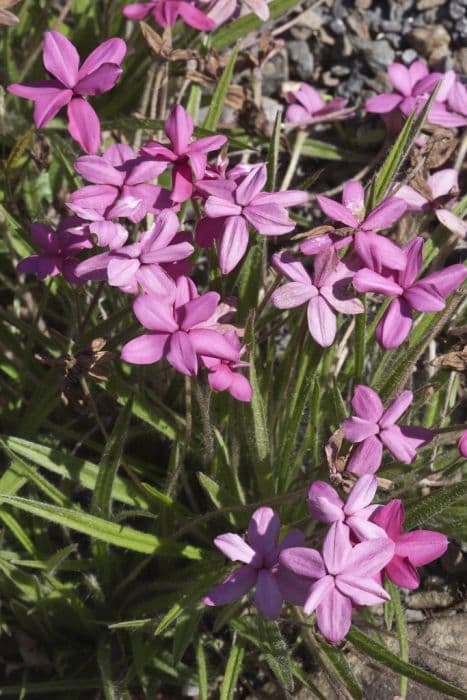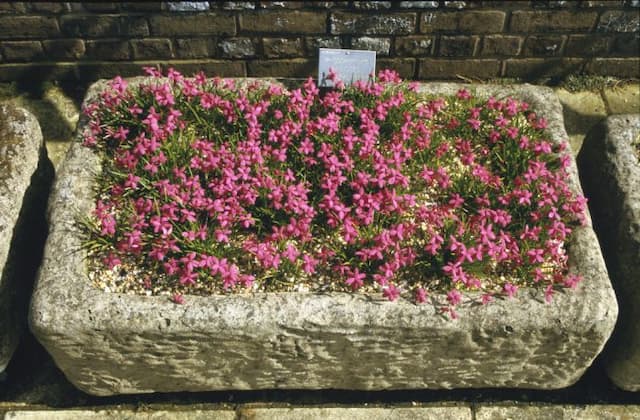Red Star Rhodohypoxis baurii

ABOUT
Rhodohypoxis baurii, commonly known as the red star, is a charming flowering plant that adds a splash of color to garden beds and containers. Its appearance is characterized by small, star-shaped flowers that range in color from white to pink, and bright red, providing a vivid contrast against the surrounding greenery. These attractive flowers bloom in abundance, creating a carpet of color when planted in groups. The plant's foliage is equally appealing, with tufts of narrow, grass-like leaves that form neat, mounded clumps. The leaves are bright green and contribute to the plant’s lush, textured look. With its tight growth habit, the red star is a popular choice for rock gardens, alpine displays, and as an edging plant. During the blooming season, the red star becomes a focal point thanks to its prolific flowering nature and the rich colors of its blooms. Despite its delicate-looking flowers, it is a hardy plant that can endure various conditions if cared for properly. Overall, the vivid hues and compact form of the red star make it a delightful addition to any outdoor space, where its colorful display and tidy appearance can be truly appreciated.
About this plant
 Names
NamesFamily
Hypoxidaceae.
Synonyms
Red Star, Baur's Rhodohypoxis, Rhodohypoxis.
Common names
Rhodohypoxis baurii
 Toxicity
ToxicityTo humans
Rhodohypoxis baurii is commonly known as Rhodohypoxis. There is no significant evidence to suggest that Rhodohypoxis is toxic to humans. Generally, it is considered a safe plant with no well-documented toxic effects from ingestion. Therefore, no specific symptoms of poisoning are associated with this plant.
To pets
Rhodohypoxis baurii, commonly known as Rhodohypoxis, is not widely recognized as a toxic plant to pets. There is a lack of substantial evidence indicating that it poses a risk of toxicity to animals such as cats and dogs. Consequently, no specific symptoms of poisoning by ingesting Rhodohypoxis have been reported.
 Characteristics
CharacteristicsLife cycle
Perennials
Foliage type
Deciduous
Color of leaves
Green
Flower color
Varies
Height
0-4 inches (10-10 cm)
Spread
0-4 inches (10-10 cm)
Plant type
Bulb
Hardiness zones
7
Native area
South Africa
Benefits
 General Benefits
General Benefits- Easy to Grow - Rhodohypoxis baurii, commonly known as the Red Star plant, is relatively easy to grow and care for, making it suitable for gardeners of all skill levels.
- Attractive Flowers - It produces attractive star-shaped flowers that enhance the aesthetics of gardens and outdoor spaces.
- Ground Cover - Its dense growth habit makes it an excellent ground cover plant, filling in areas and suppressing weeds.
- Container Gardening - Red Star is suitable for container gardening, allowing those with limited space to enjoy its beauty.
- Drought Tolerant - Once established, it is quite drought-tolerant, requiring minimal water and reducing the need for frequent irrigation.
- Seasonal Interest - It blooms in late spring to summer, providing seasonal interest and color variation in the garden.
- Rock Gardens - Red Star is an ideal choice for rock gardens due to its compact growth and tolerance of poor soil conditions.
- Companion Planting - The plant can be used effectively in companion planting, complementing other garden plants with its low profile and vibrant flowers.
- Border Plant - It works well as a border plant, defining garden edges and pathways.
- Pollinator-Friendly - Rhodohypoxis baurii attracts pollinators such as bees to the garden, supporting local ecosystems.
 Medical Properties
Medical PropertiesThis plant is not used for medical purposes.
 Air-purifying Qualities
Air-purifying QualitiesThis plant is not specifically known for air purifying qualities.
 Other Uses
Other Uses- Rhodohypoxis baurii, commonly known as small red star, can be used in miniature gardens due to their diminutive size, adding a colorful ground cover that complements other miniature plants.
- The plant can serve as a living carpet in alpine troughs and sinks, offering a lush, vibrant underplanting that benefits from the well-drained conditions.
- Small red star is sometimes utilized in fairy gardens because of its small, delicate flowers and foliage that fit into the fairy-tale aesthetic.
- In floral art, the flowers of Rhodohypoxis baurii can be used to create intricate and delicate designs due to their small size and vibrant color.
- The plant can be used in photography as a macro subject to showcase the inherent patterns and details of the tiny flowers up close.
- Craft enthusiasts sometimes press the flowers of the small red star to create natural decorations for handmade cards or bookmarks.
- As a potted plant gift, these flowers are often given to symbolize appreciation and love, especially during the blooming season as a living alternative to cut flowers.
- Rhodohypoxis baurii can be used in educational settings such as schools to teach children about plant life cycles and botany, given its easy-to-observe flowering behavior.
- During seasonal celebrations, the plant can be used as a natural table decoration, adding a splash of color to festive arrangements.
- Gardeners may use the small red star in green roofs projects where low-maintenance and shallow-rooted plants are beneficial for creating sustainable and visually appealing structures.
Interesting Facts
 Feng Shui
Feng ShuiThe plant Rhodohypoxis baurii is not used in Feng Shui practice.
 Zodiac Sign Compitability
Zodiac Sign CompitabilityThe plant Rhodohypoxis baurii is not used in astrology practice.
 Plant Symbolism
Plant Symbolism- Resilience: Rhodohypoxis baurii, commonly known as Red Star, often blossoms abundantly after surviving harsh winter conditions, symbolizing the ability to endure and thrive despite adversity.
- Purity: The Red Star's simple yet striking flowers are associated with purity and cleanliness, perhaps due to their crisp and bright appearance.
- Hope: The Red Star blooms with the onset of spring, bringing with it a sense of hope and renewal as the seasons change from the cold dormancy of winter to the warmth of spring.
- Charm: With its small, star-shaped flowers, the Red Star can symbolize charm and enchantment, often captivating the hearts of gardeners and nature lovers alike.
 Water
WaterThe Red Star plant prefers consistent moisture during its growing period, which is from spring to fall. Water it thoroughly when the top inch of the soil feels dry, approximately once or twice a week, depending on the local climate conditions. It's important to avoid waterlogging, so ensure that the pot has good drainage. During its active growth, it might need around a quarter to half a gallon of water every week. However, in winter, when the plant is dormant, reduce watering significantly, just enough to keep the soil from drying out completely.
 Light
LightRed Star plants thrive in full sunlight to partial shade. The ideal spot for this plant would be an area that receives bright, indirect light for most of the day, but can also tolerate a few hours of direct sunlight. Avoid placing it in deep shade or intense, hot midday sun, as these conditions can either cause lackluster growth or scorch the leaves.
 Temperature
TemperatureRed Star plants do best in temperatures ranging from 50 to 75 degrees Fahrenheit. They can survive a minimum temperature of around 32 degrees Fahrenheit, but only for a short time. Ideal growing conditions are moderate temperatures without extremes, so protect the plant from frost and extreme heat.
 Pruning
PruningRed Star plants do not require extensive pruning, but deadheading the spent flowers can encourage further blooming. The best time to prune is after the flowering season, in late summer or early autumn. Lightly trim back the foliage just to keep the plant tidy and to remove any yellowed or dead leaves.
 Cleaning
CleaningAs needed
 Soil
SoilRed Star prefers well-draining soil with a mix of two parts peat or loam to one part perlite or sand, and some organic matter. Soil pH should be mildly acidic around 5.5 to 6.5.
 Repotting
RepottingRed Star should be repotted every 2 to 3 years or when it visibly outgrows its pot, ideally during the spring.
 Humidity & Misting
Humidity & MistingRed Star thrives in moderate humidity levels, avoiding excessively humid or dry conditions.
 Suitable locations
Suitable locationsIndoor
Place Red Star in bright, indirect light and ensure good air circulation.
Outdoor
Plant Red Star in partial shade with protection from strong midday sun.
Hardiness zone
5-9 USDA
 Life cycle
Life cycleRhodohypoxis baurii, commonly known as the Red Star, begins its life cycle when its seeds germinate in late winter or early spring, given sufficient moisture and cool temperatures. The seeds develop into small bulb-like corms that produce grass-like leaves and star-shaped flowers mainly in pink, red, or white colors during the late spring and summer months. After flowering, the plant enters a period of dormancy in late summer or autumn as the leaves die back; during this time, the corms rest beneath the soil surface. Throughout the dormant season, the corms survive the colder temperatures until conditions are favorable for regrowth. With the return of warmer temperatures in spring, the corms initiate a new cycle of growth, developing fresh foliage and preparing for the next flowering season. Red Stars can propagate both by seed and division of corms, with the latter being a common method for gardeners to increase their stock of the plant.
 Propogation
PropogationPropogation time
Spring to summer
Propogation: Rhodohypoxis baurii, commonly known as the Rhodohypoxis or Rose Grass, is best propagated by division. This should be done when the plant is dormant, typically in the late autumn months after the foliage has died back or early spring before growth begins. To propagate, carefully lift the plant from the ground or its container. The corm-like structures at the base, which resemble small bulbs, can be gently separated by hand. Each division should have some roots attached. These divisions can then be immediately replanted into a well-drained soil mix, spaced at about 4 inches (approximately 10 centimeters) apart, and at a depth where the top of the corm is just below the surface of the soil. Water the new plantings moderately to help establish roots.
